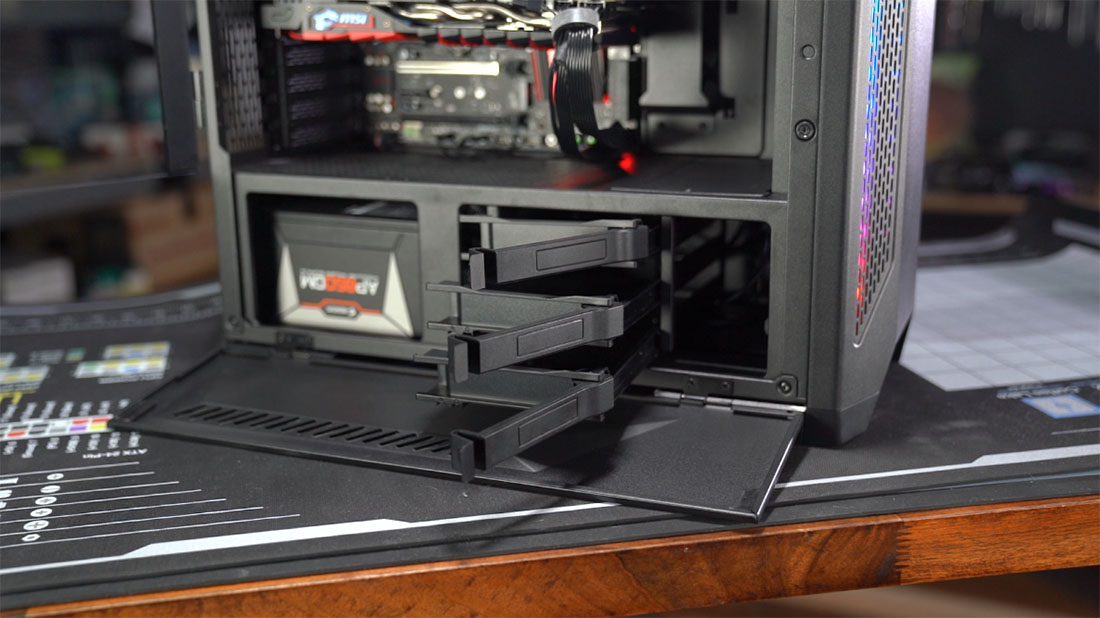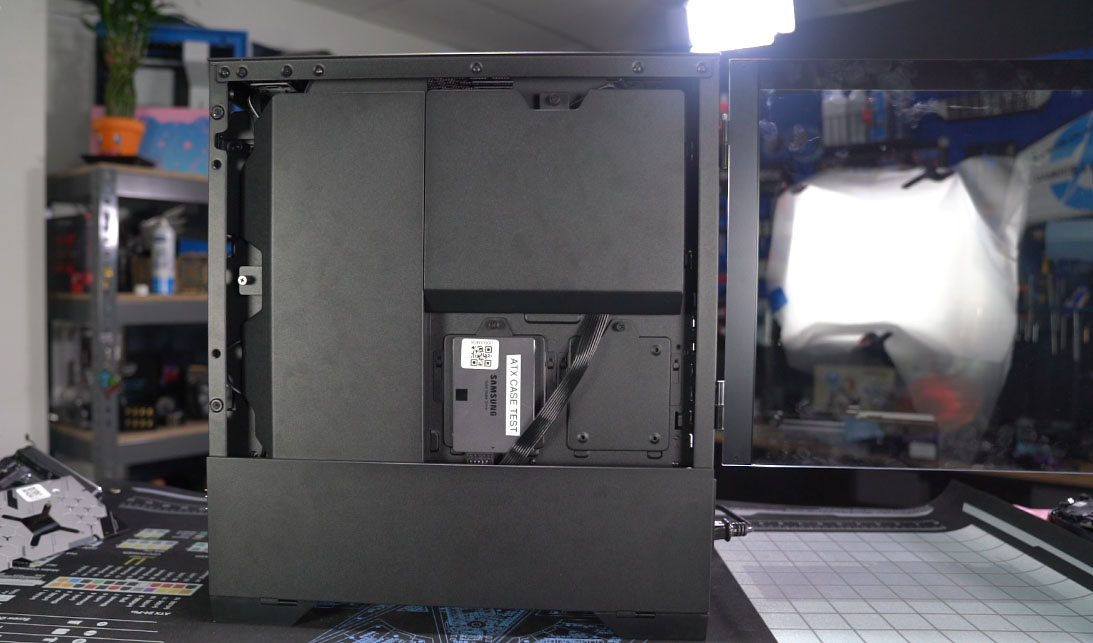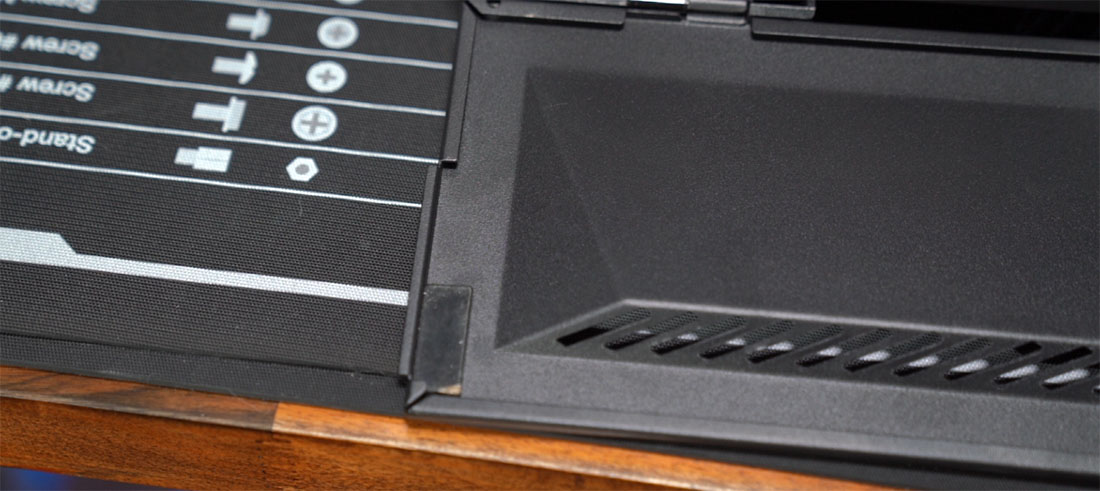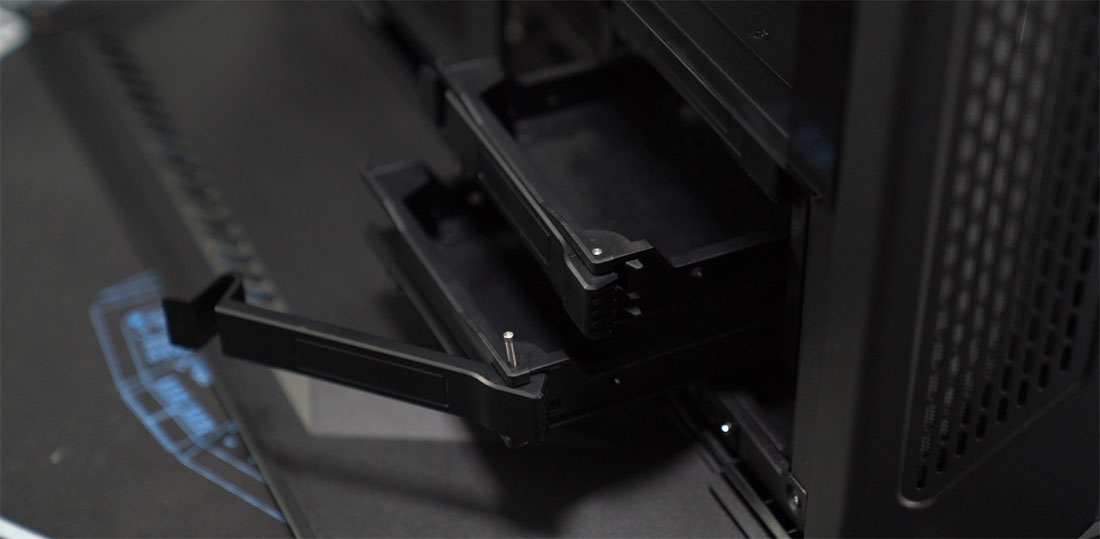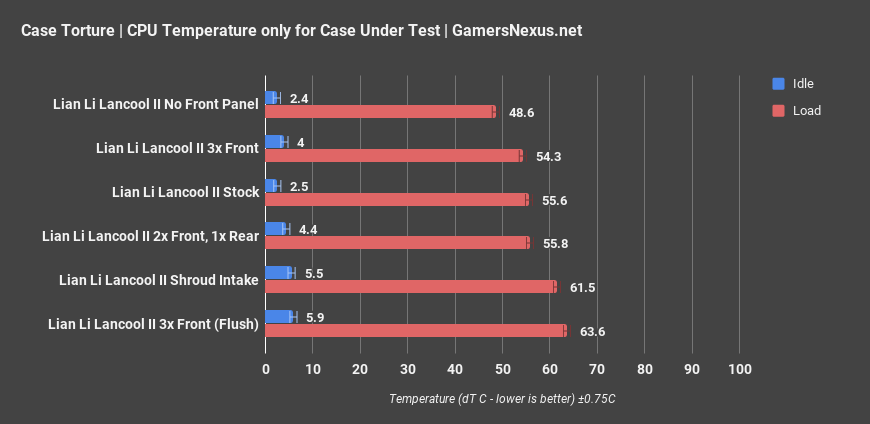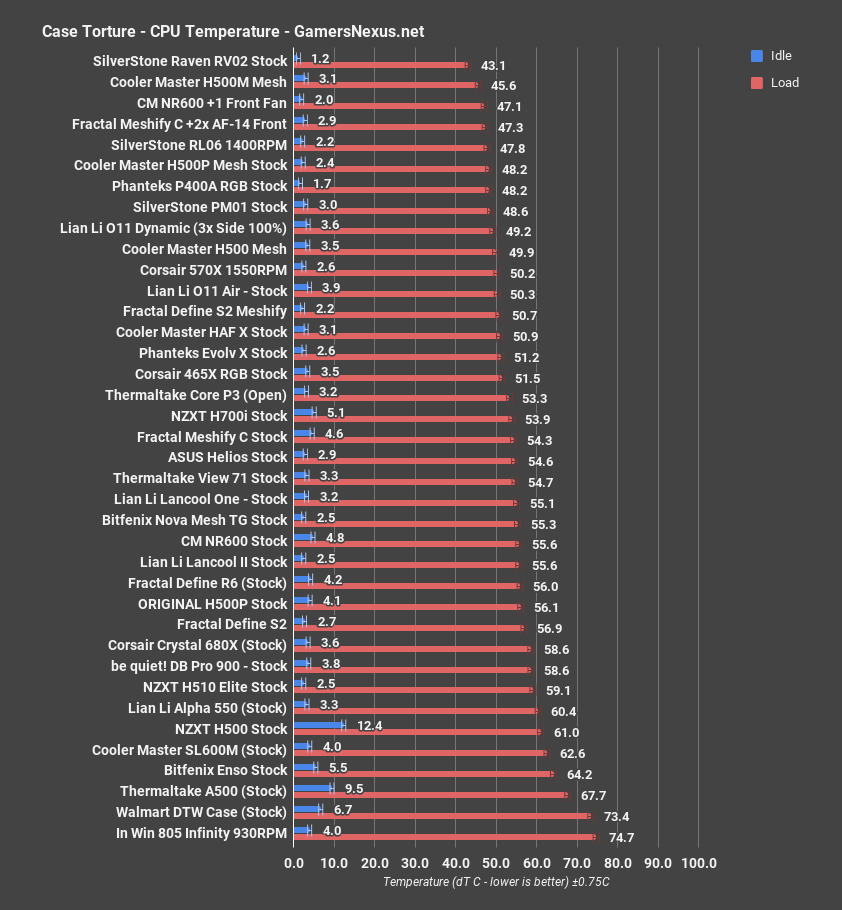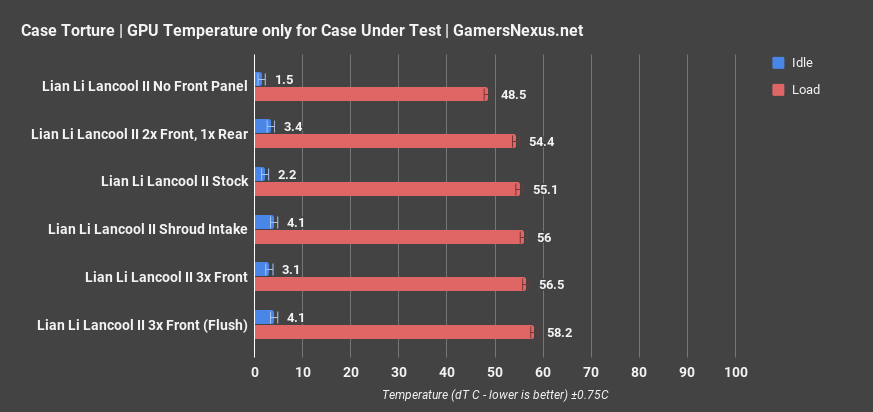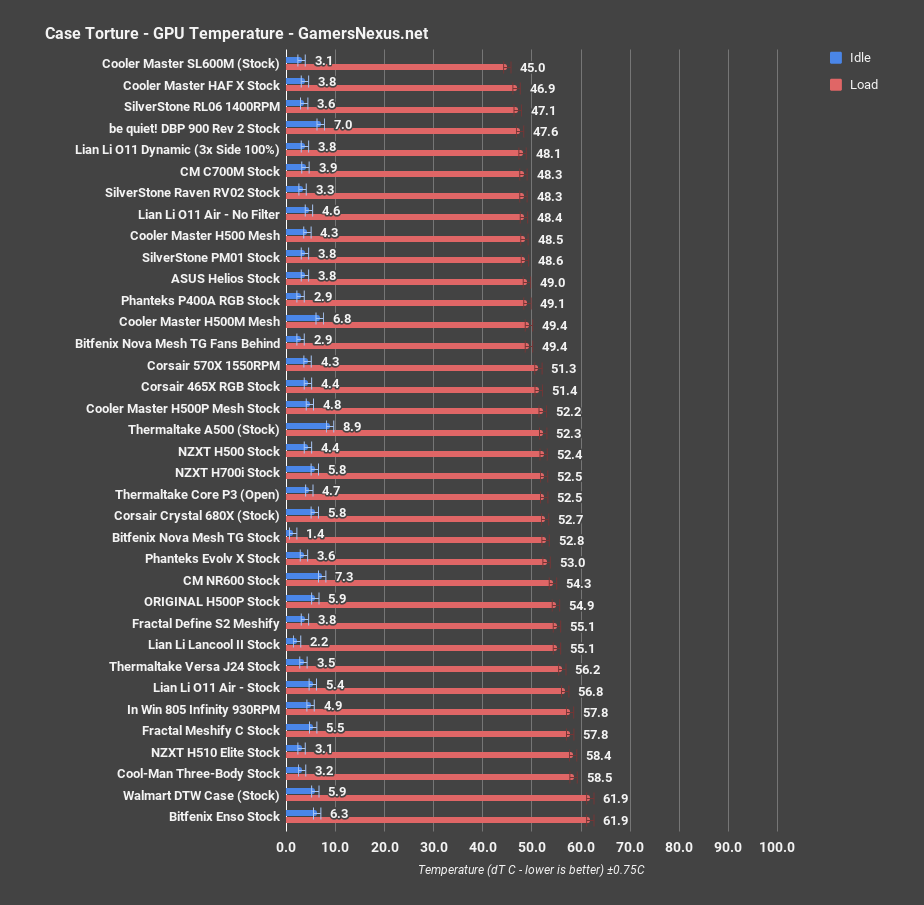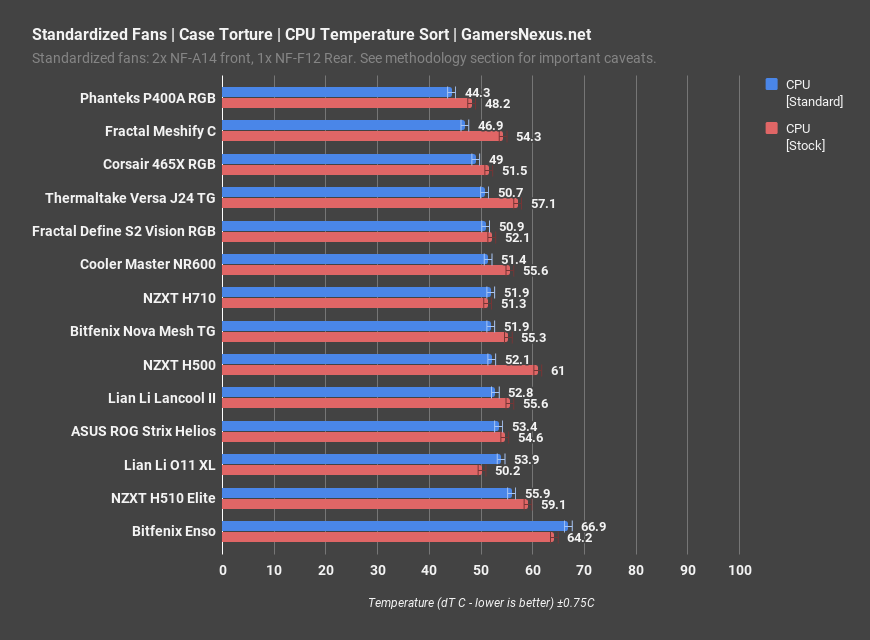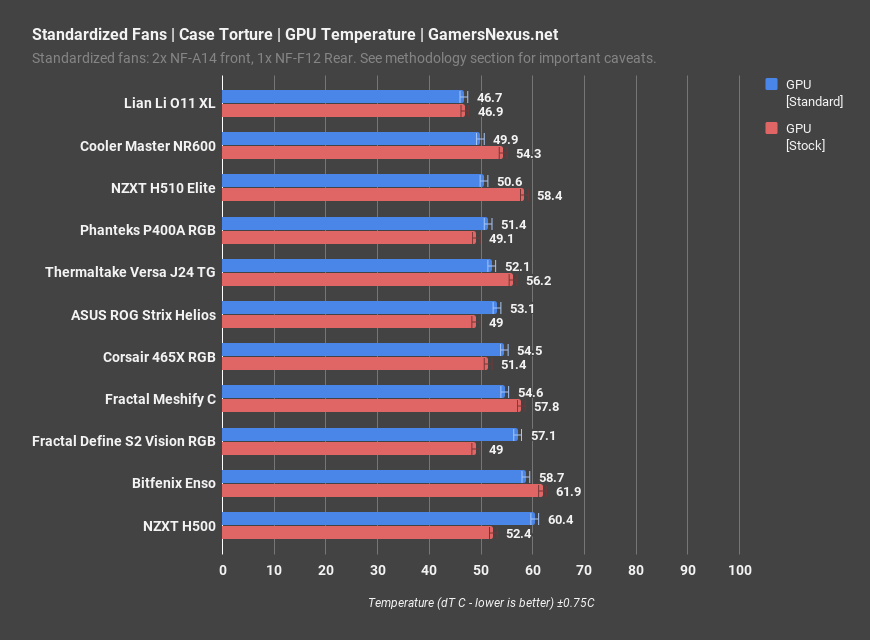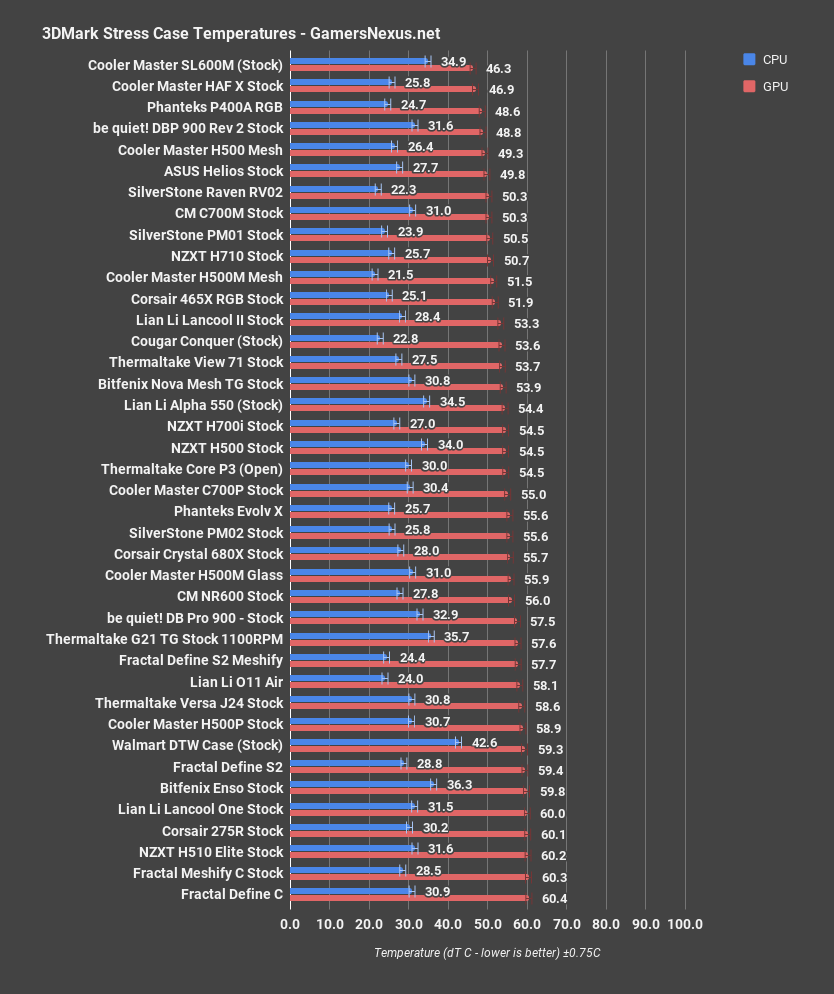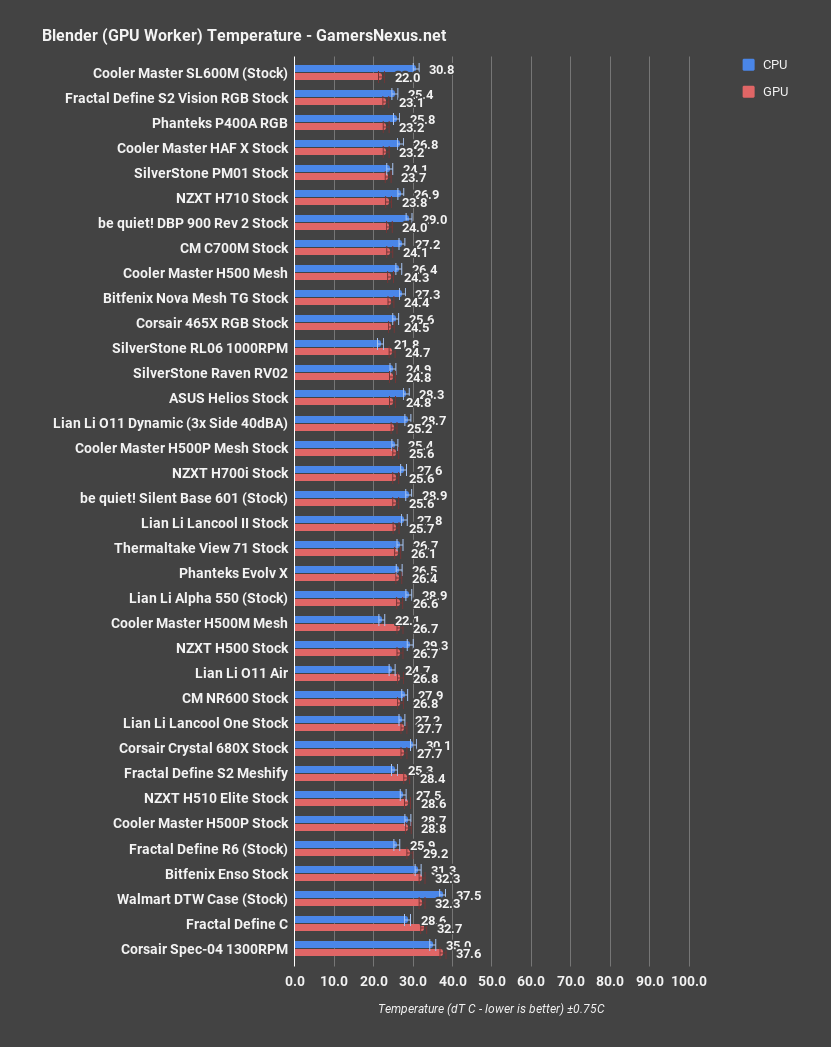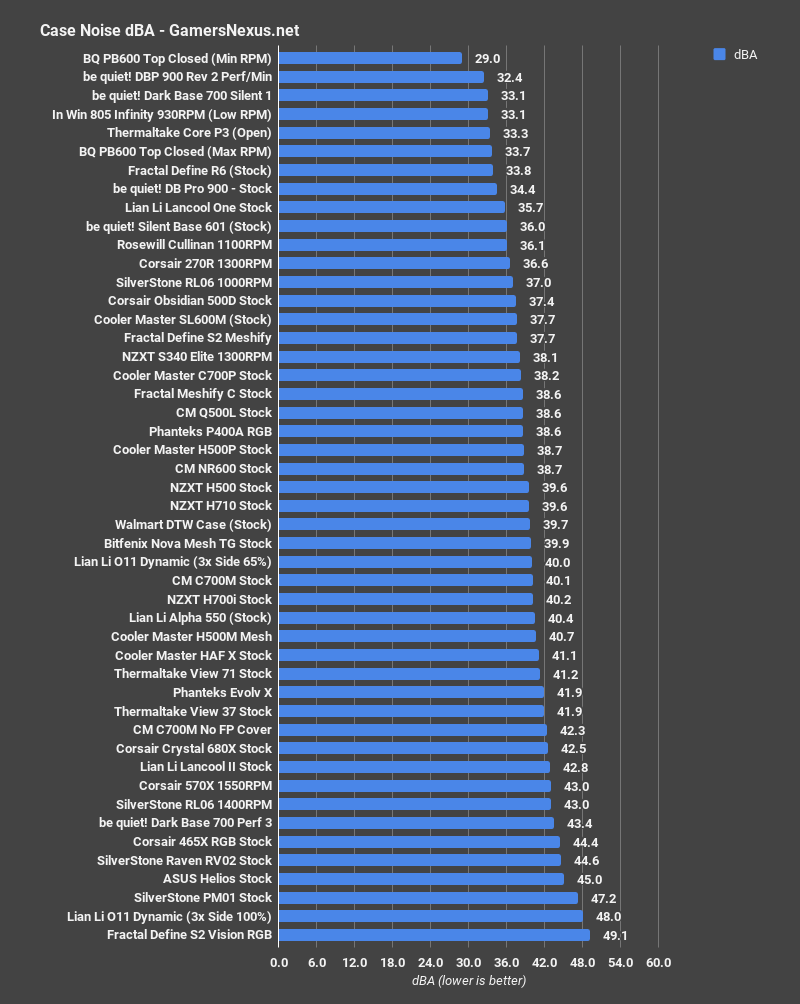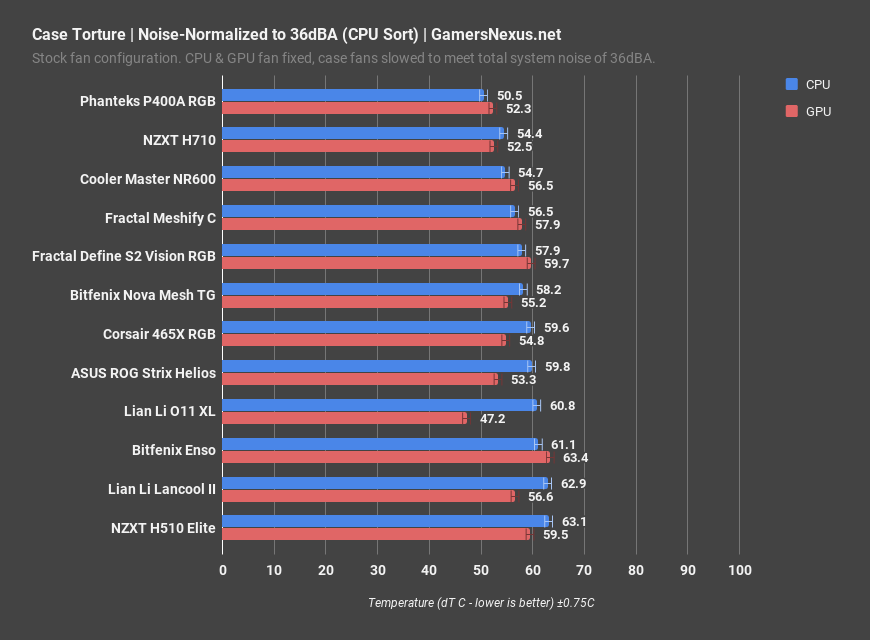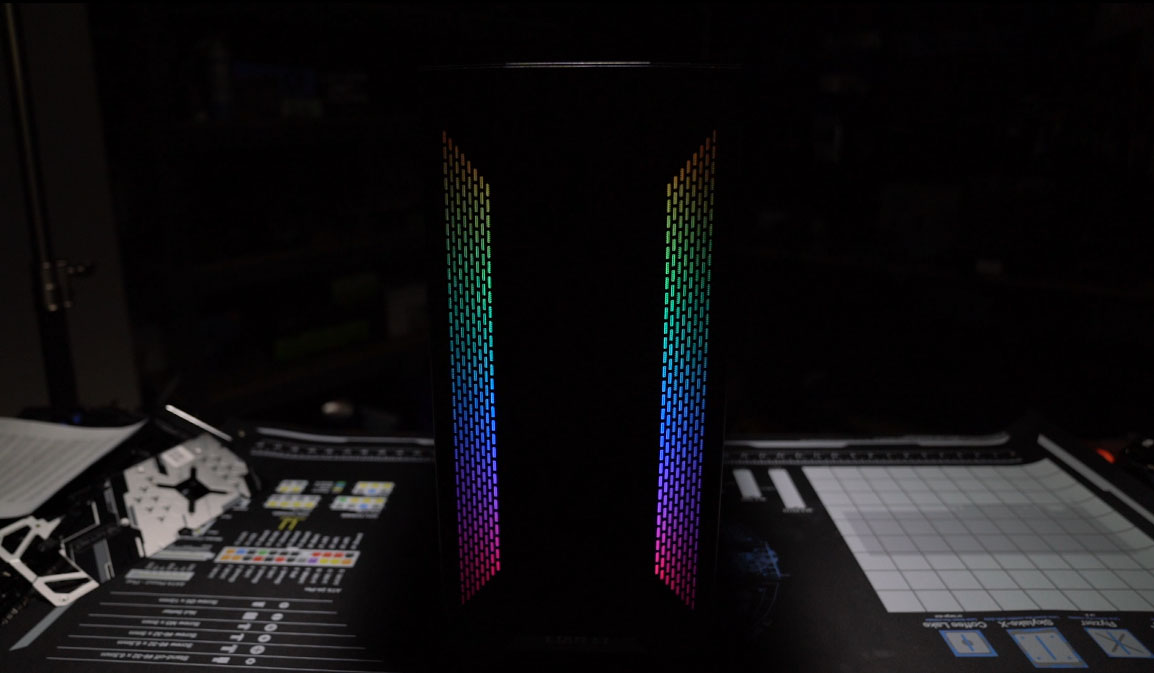The Lian Li Lancool II is another budget case effort from Lian Li--budget relative to the rest of Lian Li’s past cases, at least. It’s the successor to the identically MSRP-ed $90 Lancool One, a case that we were mildly pleased with at the time but lacked the wow factor of Lian Li’s O11 line. The white version is $5 more, but Lian Li wisely sent the black one for review. The Lancool II has already gained a few points in our book just by being a “sequel” case that doesn’t look the same or worse than the original. In 2018, the year the Lancool One launched, our award for Best-Worst Case Trend went to pointless refreshes.
There were some fit and finish issues with our review sample, but let’s cover the features of the case first to provide some context.
The side panels are subdivided into two sections each: the bottom quarter or so below the level of the PSU shroud is steel and hinges down along the bottom edge of the case, and the top section above the PSU shroud is tempered glass and hinges back along the rear edge of the case. The glass sections can be lifted off of their hinge pins when opened, and the hinge pins are of unequal length to make indexing the door easier when replacing it. Closure for both sets of doors is magnetic, without any optional screws for secure transportation, so be careful lifting it. There’s also no way to open the top set of glass doors without opening another panel: there are no handles except on the steel doors, and the glass edges are all nested behind other parts of the case. It makes the case look sleek, but we’d appreciate a tiny cutout anywhere on the chassis to allow prying the glass open without opening the steel door first.
Lian Li Lancool II Case Specs
Model | LANCOOL II – X | LANCOOL II -W |
Color | BLACK | WHITE |
Dimensions | (D) 478 X (W) 229 X (H) 494 | |
Motherboard | E-ATX/ATX (width: under 280mm)/M-ATX/ITX | |
PSU | 210mm | |
Materials | 0.8mm SGCC (Exterior, MB tray, and most of the interior) 4.0mm tempered glass (both sides) | |
Fan Support | Front (multi-way fan/radiator bracket): 3 X 120mm or 2 X 140mm Above PSU Chamber: 2 X 120mm Top: 2 X 120/140mm Rear: 1 X 120mm | |
Radiator | Front (multi-way fan/radiator bracket): 1 X 360/280/240mm Top: 1 X 240mm (aligned to the left) | |
VGA Length | 384mm | |
CPU Clearance | 176mm | |
Drive | Behind MB Tray: 2 X 2.5″ SSD Hard Drive Cage: 3 X 3.5″ HDD/2.5″ SSD Behind the Right-side Shroud Panel: 2 X 2.5″ SSD | |
Slot | 7 | |
I/O Ports | 2 X LED Control Buttons (M & C) 1 X TRRS AUDIO 2 X USB 3.0 1 X USB 3.1 TYPEC (Optional) | |
Dust Filters | 1 x Top (magnetic), 1 x Front Panel (magnetic), 1 x Bottom (tray) | |
Inc Fans | 3 X 120mm (Front, Top, Rear) | |
The hinges on the steel section are screwed into place and therefore not as easy to remove. At first, we thought it was odd to have subdivided the panels like this -- at least, beyond being a marketable gimmick -- as it just complicates everything. There are a few benefits, though: First, since it’s so short, the steel section can be opened even in confined spaces to allow access to the hot-swap HDD bays under the PSU shroud. Second, there are vents punched into the steel that can provide air to fans mounted on top of the PSU shroud--vents that couldn’t be punched into glass. The “handle” we mentioned on this panel is just a rim on the back edge that allows prying it out.
The hot-swap style sleds are a neat feature in a case this cheap, but for them to be literally hot-swappable, as they’re marketed, a backplane is required--and a free backplane only comes with preorders, if the Newegg listings are any indication, and we aren’t big fans of seeing video game-style in-game pre-order rewards bleeding into physical products. Lian Li did ship us a backplane along with many other optional extras, but we don’t support preorders and we wanted to test this case as it will ship for $90, so we didn’t install any of them. The hot-swap feature is cool, but the usefulness of hot-swapping drives in a desktop computer with a cage that can only hold three hard drives is debatable. Maybe there are people out there who think they need this, but those who actually do have to be pretty rare. One example use case would be that you’ve configured a RAID5 set of three hard drives in your $90 case and that you also had a drive fail within the life of the system, and that you also needed to keep the system online while swapping-in the replacement drive for a RAID rebuild. The odds of all this happening are unlikely, but technically possible.
The cage is removable (which would provide extra air to any fans on top of the PSU shroud) and it can also be repositioned within the shroud. Facing the case, drives eject to the left, opposite from the usual direction. The hard drive cage can’t be flipped around to eject from the right, even though it looks like this would be possible with maybe one extra screw hole. We’d like to have seen that optional modularity added, as we couldn’t identify a reason that it would be impossible once that extra hole is added.
The front fan/radiator tray is one of the high points of this case: not only is it removable, but it can be flipped around and repositioned a total of four different ways, and of course fans can be installed on either the front or the back of the tray. The tray fits into place snugly, it can be removed with two thumbscrews, and it provides an excellent degree of flexibility with fan placement. Whether that’s helpful in this specific case will be covered in the thermal section, but it’s a good idea regardless. We greatly appreciate when cases make it possible to configure fans and radiators externally from the case, as it makes screwdriver access much straighter and quicker. This is especially useful if testing fitment of liquid cooling parts -- either open- or closed-loop -- prior to complete assembly. Lian Li can claim a job well done on this aspect.
Cable covers are often pointless; Cooler Master is especially prone to putting them in cases that don’t need them. The Lancool II does need them, since both side panels are transparent and held down by magnets, and the two large covers over the back of the motherboard tray do a good job of keeping things tied-down and looking neat. Having two clear side panels doesn’t look terrible for once. Between that, the velcro tie points, the large and plentiful cutouts, and the big air gap between the PSU and shroud, cable management in every part of the case was excellent. The cable management bar is nicely sized, and it can be moved closer to the front of the case to extend the motherboard tray for E-ATX support just a little without removing functionality. There’s also a mysterious third cover over the back of the CPU socket. We gather from the manual that this is supposed to provide a mounting location for sticking on third-party RGB or fan hubs, which is a thoughtful touch considering that Lian Li doesn’t use that mount for their own RGB controller.
The front panel includes a combined audio jack, two USB 3.0 ports, and an optional USB 3.1 type-C port. “Optional” here means that, if your case doesn’t come with the port, it still comes with an empty hole with a rubber plug in it. Maybe that’s a positive, since it allows the user to add their own cable later if they need it, but it would have been nice to have a recessed plastic blank instead of a hole. The front I/O also includes power/reset buttons and two rectangular buttons labelled “C” and “M” to control RGB color and mode. We appreciate good built-in RGB controls, even if these buttons are very obviously replacing what were two additional USB ports. It can also accept external ARGB control via a 5V connector.
We rarely comment on the appearance of RGB effects anymore, but the lighting on the Lancool II’s front panel is impressively bright and even across both strips of mesh. Buyers should be aware that the LEDs are integrated into the front panel, not the fans: RGB fans installed in the front of this case are a waste, as they’ll be hidden. That also means that the stock fans are freely repositionable without ruining the lighting effects. This is an area where cases like the Phanteks P400A Digital are weak: because it has ARGB fans that are intended to be installed in the front panel, users who want to rearrange the stock fans to make room for a radiator or get better airflow are forced to break up the intended lighting. The front panel LEDs are connected to the rest of the case with spring-loaded pins on the chassis. We like this system, but the metal contact pads have already gotten pretty scratched up, so it remains to be seen how durable it is.
Now for the fit and finish problems that we mentioned earlier. Lian Li deserves a lot of credit up-front for some very good panel fitment; the hinged glass panels are only directly attached to the case on one edge, so the fact that they swing shut and nest into place without catching or leaving large gaps is impressive. The same goes for the front panel, which is relatively easy to remove without being loose. The chassis itself is up to the standards we expect from Lian Li. The problems are with the little flourishes they’ve added, much like the fragile plastic snaps in the O11 XL.
The magnets that hold the steel panel sections shut are the brittle silver-y kind -- we’re not magnet experts, but maybe neodymium -- and are therefore tucked inside the corners of the panels for protection. Only one of the four steel panel magnets on our sample was positioned correctly, and the rest were left to slam against the chassis as the door shuts. One had already been chipped when we received it.
The hard drive sleds are another weak point. They came loose during shipping, which isn’t a big deal, but when replacing them, we noticed that two of the sled hinge pins were loose to the point of falling out. We hammered in the pin on one just to make sure that’s how it was supposed to be assembled, and left the other a little loose so we could show it on camera. Again, the hot-swap idea is cool, but adding a fancy yet unnecessary feature to a case and then implementing it in the cheapest way possible pleases no-one. Either commit to making this a budget case and skip the optional add-ons (our preference), or make this a $200 case and go all-in on quality to compete for the Phanteks Evolv X fans. This isn’t to speak of the sleds themselves, wherein some of the cost savings become apparent from the cheap nature of the thin plastic execution. It’s not like it matters much from a functional perspective, though, so we can mostly ignore this point.
GN Case Testing Bench
| Component | Courtesy Of | |
| Video Card | MSI GTX 1080 Gaming X (OC Mode) | MSI |
| CPU | Intel i7-6700K @ 4.4GHz | GamersNexus |
| CPU Cooler | MSI Core Frozr L | MSI |
| Motherboard | MSI Z170A Gaming M7 | MSI |
| Memory | Corsair Vengeance LED 32GB 3200MHz | Corsair |
| SSD | Samsung 850 EVO 120GB | Samsung |
| PSU | Corsair RM650x | Corsair |
| Cables | CableMod Pro Mesh Cables | CableMod |
| Case | This is what we're testing! | - |
The video card is configured to run at 55% fan speed at all times.
Prior to load testing, we collect idle temperature results for ten minutes to determine the unloaded cooling performance of a case's fans and air channels. Thermal benchmarking is conducted for 1400 seconds (23 minutes), a period we've determined sufficient for achieving equilibrium. The over-time data is aggregated and will occasionally be compiled into charts, if interesting or relevant. The equilibrium performance is averaged to create the below charts.
Load testing is conducted using Prime95 LFFTs and Kombustor “FurMark” stress testing simultaneously. Testing is completely automated using in-house scripting, and executes with perfect accuracy on every run.
Thermals & Noise
Because of the amount of buzz surrounding this case, we took our time and tested a few more configurations than we usually do. The case comes with three 120mm fans, installed as rear exhaust, top exhaust, and front intake. Beyond the usual set of tests, we tried moving the top fan to the front of the case (two intake, one exhaust), moving the top fan to the surface of the PSU shroud (two intake, one exhaust), and sticking all three fans on the front of the case (three intake). Since the fan tray can be moved around, we also tried pushing it forward a little to get the fans even more flush with the mesh filters. We already had enough variables to test that we didn’t try removing filters, but obviously thermals could be improved a little further by opting to do without filters--the one on top of the case is unnecessary with a top exhaust configuration, for example. The front filters are necessary for the lighting effects, so it’s hard to imagine anyone choosing to do without them.
CPU Torture
We’ll start with only the Lancool II, then add other cases in a comparative chart. Starting with our normal torture workload, the stock case configuration maintained an average of 55.6 degrees Celsius delta T over ambient. Removing the front panel altogether lowered that average to 48.6 degrees over ambient, which isn’t the biggest change we’ve seen from removing a front panel; that said, there’s also only one intake fan being restricted by it in the stock configuration, so the impact is lessened than we’d see in an intake-heavy configuration. Moving the top exhaust fan to the surface of the PSU shroud had a predictably negative impact on CPU thermals, raising the CPU average temperature to 61.5 degrees delta T, since in the top slot it functions as CPU exhaust but on the shroud functions as GPU intake. More on that soon. Moving it to the front panel instead left the CPU temperature not significantly changed. In contrast, sticking all three fans in the front of the case benefited CPU thermals slightly, lowering the average down to 54.3 degrees with the extra volume of cool air pumped through the case. Moving the fans up to be flush with the mesh filters normally wouldn’t be a bad thing and would help prevent some hot air from recirculating around the fans, but this isn’t a mesh-fronted case--120mm fans actually fit completely within the space between the front vents, so moving them forward just puts them flush with an unventilated metal sheet. We’ll show a broll shot of this to really illustrate the issue, assuming we haven’t already. This scored the worst result of all, at 63.6 degrees over ambient.
Relative to our other cases, 55.6 degrees for CPU dT is on the warm side of average, approximately equal to the Lancool One. The Lancool One only comes with two fans, though, where the Lancool II has two out of its three total fans dedicated specifically to CPU cooling. It’s not an especially impressive performance when compared to its predecessor, which already wasn’t topping the charts. It’s close to the Cooler Master NR600 and Nova Mesh TG as well, two mesh-fronted cases that only include two 120mm fans apiece and therefore don’t have stellar stock performance. The front panel is optimized for LEDs first, thermals second--that’s not a dealbreaker for everyone, but it’s important to be aware of.
GPU Torture
GPU thermals are next, first focusing on the Lancool only. The average GPU temperature for stock performance was 55.1 degrees over ambient. The best possible no-front-panel temperature was 48.6 degrees dT, almost exactly mirroring the CPU deltas for these tests. Again, there’s only one intake fan being affected by the removal of the front panel, and it’s doing the job of both CPU and GPU intake. We expected moving the fan from the top of the case to GPU intake to help GPU thermals, since it’s a direct intake fan placed right under the GPU die; however, this test averaged 56 degrees Celsius GPU dT, slightly worse than baseline. Fans placed on top of the PSU shroud have one real intake path, and that’s a small vent in the steel side panel, which means that it’s both restricted and encouraged to recirculate hot air through the empty fan slot next to it instead. Further, this vent is far enough that the static pressure requirement effectively guarantees no reasonable fan will be able to maintain pressure at that distance. With the fan as exhaust at the top of the case, it doesn’t directly benefit the GPU, but it’s unrestricted and contributes more to the overall case airflow. Don’t use the PSU shroud mounts at the expense of cooling elsewhere. Moving the top fan to the front panel instead left GPU dT within margin of error of baseline, while moving all three fans to the front of the case was surprisingly counterproductive, with a warmer-than-baseline average of 56.5 degrees over ambient. The case isn’t getting rid of the GPU’s heat fast enough. There’s no really great way to get a bunch of cool air to the GPU with just the stock fans. Moving the three fans up to be flush with the front filter raised temperatures further to 58 degrees for the same reasons described in the CPU section.
Now for the comparative thermals: The GPU baseline was better than the Lancool One this time, at 55 degrees versus 57 degrees dT. Like the CPU thermals, 55C is still on the warm side, and we had a hard time improving significantly over that average without additional fans. Air-cooled GPUs in this case deserve additional fans in the front panel or the PSU shroud. There are definitely ways to move enough air through the Lancool II, it’s just hard to get the job done with only the stock fans. 55 degrees is a bit warmer than the original H500P, which was terrible in most ways thermals, and equal to the stock Meshify C (the Meshify C requires some additional fans to perform really well).
Standardized Fans
Our standardized fan test was added this year, but the chart continues to grow with each review. For this test, we replace all the stock fans with three Noctua fans, two 140mm and one 120mm, and ideally configure them as we did in this case: We set the 140mms as intake and the 120mm as exhaust, noting critically that this test sometimes worsens performance of cases which are already well-optimized for their stock configuration. This is thus far rare, but happens sometimes. The Lancool II averaged 53 degrees CPU dT with these fans, about 3 degrees better than the stock test. Compared to our other cases, that’s still warmer than the median, on par with the NZXT H500 or the ROG Strix Helios. The mesh-fronted cases like the Meshify C are generally cooler, but not incredibly so for some of the more restrictive ones, like the 51.9-degree Nova Mesh TG.
Standardized testing for the GPU is next. The GPU averaged 57. Degrees over ambient, a couple degrees warmer than baseline. Forcing a straightforward front-to-back airflow pattern doesn’t perform as well as the stock layout, as the negative pressure stock setup is encouraging airflow through the PSU shroud and the large holes in the back of the case, all feeding into the GPU cooler and up to the top of the case. Compared to our other tested cases, 57.4 is definitely getting hot, about equal to the S2 Vision RGB but and approaching the Enso and H500; note that the H500 is one of the instances where standardized fans significantly hurt performance, as it’s built for 2x 200mm intake fans. None of our tests with the stock fans revealed an easy way to improve GPU temperatures, so we’d recommend adding at least one more fan rather than trying to find a way to make a 3-fan configuration work.
3DMark
3DMark Firestrike Extreme’s stress test is GPU-intensive and realistic to a gaming workload, and our test GPU averaged 53 degrees Celsius over ambient under this workload. That’s close to the Thermaltake A500, and definitely much cooler than the Lancool One’s 60-degree average. Sometimes, our 3DMark stress testing shows different results than the torture testing thanks to the limited heat generated by the CPU, and this is one of those instances. With mostly the GPU generating heat, the Lancool II is capable of keeping up and cooling at an average level.
Blender
Blender rendering on the CPU averaged 37 degrees over ambient, almost equal to the Lancool One, and relatively more competitive than the CPU temperatures from the combined torture test. Loading the CPU and GPU heavily at the same time seems to be what really overwhelms the Lancool II.
Rendering with CUDA shifts load to the GPU, so the 25.7-degree GPU result still lands in just about the middle of the chart, and a couple degrees cooler than the Lancool One.
Noise & Noise Normalized
We’re now moving to noise testing, then noise-normalized testing. We’ll first look at a noise-only chart. With the case fans set to 100% speed and reportedly running around 1400RPM, case noise hit 42.8 dBA. That’s noisy, especially for a case that doesn’t have all three fans installed behind a mesh front panel. The nature of the Lancool II’s front panel means that air will always be forced through weird angles and layers of filtration that will add to turbulence and noise with the fans at high speed, and the flow impedance created by the front panel means that the fans should probably be running at high speed to get the static pressure necessary to overcome the panel design. This isn’t a quiet case.
Lowering the noise level to our 36dBA threshold for noise-normalized testing required cutting the case fans to 60% speed in BIOS, or about 1000-1100RPM. We leave GPU and CPU fan speeds fixed and unmodified for this testing, allowing us to better determine who has the most efficient assortment of fans and paneling. Thermals already weren’t the best, but the speed reduction bumped our CPU up a lot, moving to 63 degrees over ambient, and GPU temperature moved up to 56.6 degrees delta T. That’s almost the worst case on the noise normalized chart so far for CPU temperature, and it’s pretty bad for GPU temperature as well, with only the Enso, Define S2 Vision, and Elite outstripping it.
Conclusion
Lian Li has packed a lot of features we’d associate with more expensive cases into a $90 package, but the implementation of those features is hit or miss. We really like the hinged magnetic panels and the front fan tray, and the LEDs are nice for those who care about that sort of thing. The hotswap backplane and USB C port being optional extras is a big miss, and we’d sooner see those features cut altogether than be done cheaply--having an empty USB-shaped hole in the front panel is just sad. Clearly Lian Li has had to fight tooth and nail to hit that $90 price point if they’re charging $5 extra for white paint (painting the case white is legitimately more difficult). Instead, we’d prefer that they get rid of the hot swap gimmick, commit to either including or eliminating the USB C port, and take more care with assembly, whatever that ends up costing. On the other hand, the lackluster thermal performance is more forgivable at $90.
Thermal performance almost takes a back seat compared to the other features of the case. Overall it’s fine, but leaning unpleasantly towards warm for a case that includes three fans. Buyers of this case should be interested in it for the pretty lights, not the airflow. The exception to this “meh” performance is the number of fan mounts, which Lian Li has maximized for a case of its size. Fan rails that extend the whole height of the front panel for 120mm and 140mm spacing, two 120mm mounts on top of the PSU shroud, and an unusually wide array of mounting options on the top panel are all above and beyond the usual options in a $90 mid tower. As long as the fans are kept back from the front panel, ventilation does exist and could be brute forced with the purchase of some additional fans--but be warned, it’ll be noisy.
Editorial, Testing: Patrick Lathan
Test Lead, Host: Steve Burke
Video: Josh Svoboda, Andrew Coleman
